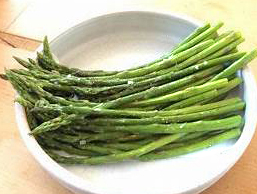Asparagus in Texas Gardens
If you want to grow asparagus, you must start in early January. Here are the pointers.

• Asparagus is a perennial vegetable. That means you need to prepare its soil carefully, because it will be growing in the same location for 10 or 15 years. The most critical thing is that you remove all weeds and grasses prior to working the soil. Asparagus does not fare well against competition.
• Asparagus grows best in full sun. The plants grow to be rather tall (5 to 6 ft.), so plant them in a way that they won’t shade the rest of your vegetables. Asparagus is actually attractive, so you can even plant a clump as a backdrop to a wide perennial garden.
• Asparagus needs well-draining soils, preferably sandy or sandy loam. It does best in soils that are neutral to slightly acidic or slightly alkaline. Add several inches of compost and other organic matter to the bed at the time that you’re preparing it.
• Asparagus plants are either male or female (dioecious). Male types will not produce the red fruit and the resulting chance seedlings that contaminate the garden. Hybrids carrying the name “Jersey” are male types. The list includes Jersey Giant, Jersey Knight and Jersey Supreme. Mary Washington, a longtime favorite, is a female selection that is not as productive nor as resistant to diseases.
• Buy vigorous 2-year-old roots from a local independent retail garden center or feed store. Beware of plants hanging in plastic bags on racks in national chain stores, especially in warm surroundings. They may already have started to grow, and they may be too weak to succeed.
• Dig trenches 10 inches deep and wide into the loose garden soil. Space them 5 to 6 feet apart in the garden. These plants grow large.
• Place the crowns 14 to 18 inches apart in the trenches. Cover the crowns with 2 inches of loose soil and firm it, but do not compact it.

• Water the freshly planted crowns slowly and deeply to settle the soil.
• As the soil in the trenches settles and as the crowns grow, gradually fill the trenches in back to the grade level.
• Apply 3 to 4 inches of loose mulch or compost to the bed to slow growth of weeds. Use a mini-tiller to eliminate any weeds that do develop, but do not till deeply lest you damage the roots.
• Water regularly and fertilize with nitrogen to keep the plants growing vigorously.
• When the first freeze kills the tops of the plants, cut the stems back to within 3 or 4 inches of the ground. By leaving the stems in place each winter they can serve as markers of where you may expect the new spears to emerge the following spring.
• You will not harvest asparagus spears until the second or third spring. The plants simply will not be strong enough.

• When your plants are old enough to produce spears, apply ammonium sulfate at the rate of 1 pound per 20 feet of row in late January to promote vigorous new spear growth. You may see recommendations that you apply a fertilizer with a significant amount of the middle number, phosphorus, but that would only apply to sandy soils that have not built up accumulations of phosphorus. Normally you will be adding nitrogen-only plant foods.
• Harvest asparagus spears as they emerge from the soil in very early spring. Harvest season lasts only six or seven weeks. From that point on you must leave the stems to develop foliage to nourish the roots for another run at vigorous growth the following spring.
• Snap or cut the stems off at or just below the ground line (never above). You can snap them with your fingers, or special asparagus knives are sold for the job.
• Mulch the plantings with 3 or 4 inches of loose compost to discourage weeds during the growing season. Keep plants moist at all times.
• When the plants turn yellow following the first freeze in the fall, cut the tops back to 3 to 4 inches above the soil line. Leave the short, dried stems in place to let you know where the crowns are so you won’t break off the developing spears the following spring.
